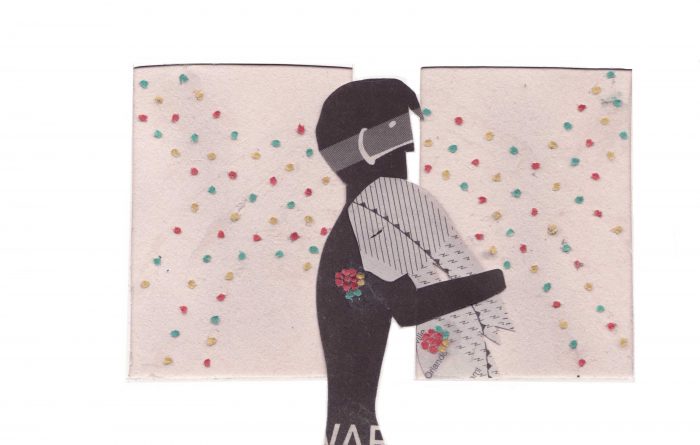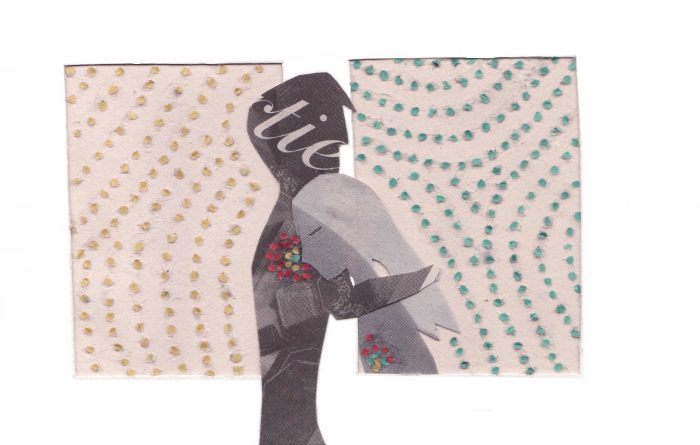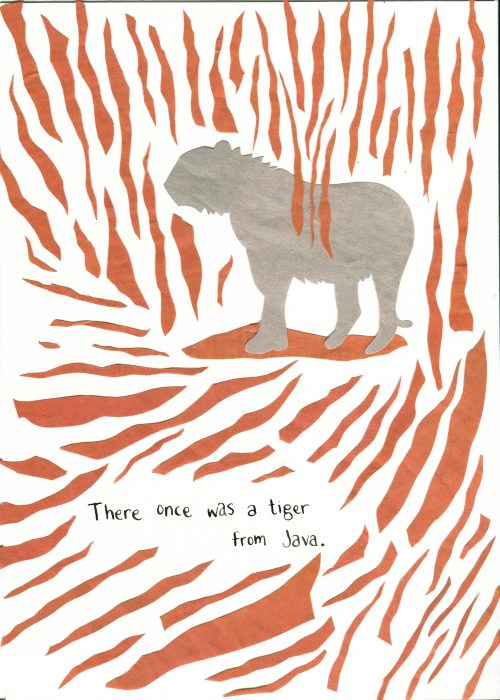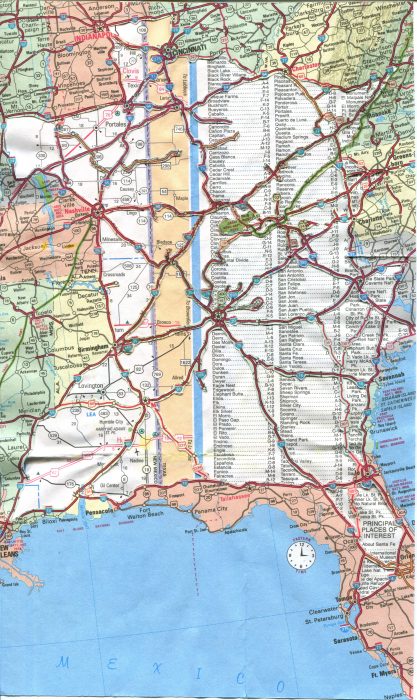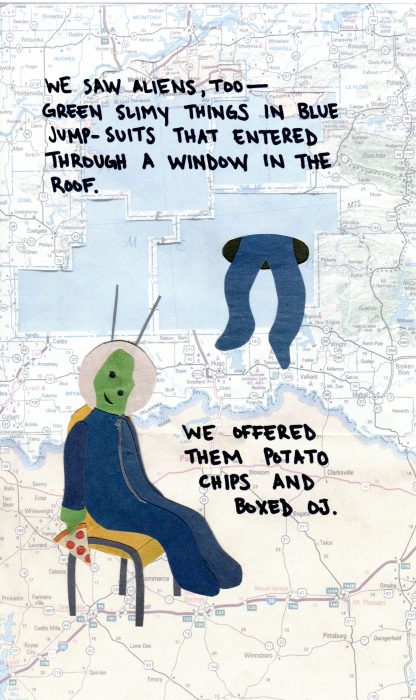If the digital age has relegated paper to an old medium, it has also changed the significance of paper’s ephemerality. Artist Mita Mahato, who works in cut paper, collage, comics, and limericks, has been exploring this new significance in a visual idiom that is both playful and wary. We met with Mahato to discuss her work’s unique engagement with disposability, the Anthropocene, nostalgia, and survival.
–Priti Joshi and Susan Zieger
Your work uses paper that is bound for disposal: old newspapers, used gift-wrap, advertising supplements, discarded books. How do you feel paper articulates something distinctive about ephemerality in this cultural moment?
Despite it being “bound for disposal,” paper feels far less ephemeral to me than the forms of communication that our current culture has chosen as standard (text messaging, tweets, instant notifications, GPS). A few years ago, I was traveling from Las Vegas to Zion National Park with some friends and we missed a turn. The friend in the “shotgun” seat opened the glove compartment to look at the paper map provided by the rental car agency. Everything we needed was there on that square of paper, yet the two of us seated in back grew impatient watching our front-seat navigator turn the map this way and that to ensure our correct route. We pulled out our phones and, one minute later, were on our way. But what would have changed had we relied upon that paper map (a map designed with a singular locality in mind, with singular purpose)? Would we have taken in the scenery in a different way? Would our eyes have been more attentive to our surroundings? Would Michael’s voice saying, “Okay, there will be a left turn coming up,” register differently from the robotic, phone voice that said, “in 500 ft., turn left”? I think so. We were so bothered by paper and its inefficiency that we treated it like an irrelevant nuisance—something meant for disposal, despite its inarguable function and proven effectiveness. That need for efficiency and quickness comes with an attitude that balks at processing, digestion, and human engagement—and I worry is an attitude that will harden as these “social” technologies not only become standard, but unavoidable. There is a link between efficiency and ephemerality. When we don’t have to work to reach understanding, we don’t have the motivation to retain the route, the conversation, the place. Even though we have been trained to see paper as something disposable, it forces us to slow down in its moment of use [Figure 1]. I think paper can be indulgent and foster worked-for pleasure, whereas our new social technologies tend to encourage fleeting feelings or are destination-bound (that destination understood as a departure point as soon as we arrive). So, to answer your question, I think that paper sees our cultural moment’s drive for efficiency, quick accomplishment, and the next big thing, and threatens it with slowness, deliberation, pleasure.
The threat is actually the reverse of what I just described. The thoughtful engagement I associate with “paper arts” is threatened by gut-level responses and efficiency. But in my art I like to indulge paper and give it the upper-hand.
You cut up paper bound for the dustbin and paste it onto more paper in order to create new images. One could view this process as a project of preservation or conservation, moves that are sometimes charged with nostalgia. How do you see your work as addressing issues of preservation and/or nostalgia?
I think the answer to this question depends upon a third term: transformation. Most acts of preservation acknowledge the reality of transforming effects—the yellowing of paper over time; the fading effect of sunlight on dyed or painted materials; the degradation of habitat. Nostalgia is related to transformation as well; we yearn for something to be the way it was before technology, climate change, gentrification, illness, etc. transformed it (though I think that nostalgia can be dangerous in the sense that it idealizes a lost past). When I look at paper with the intention of re-purposing it, I tend to oscillate between wanting to preserve something that I see in it (a texture, a color, a set of words, a pattern) and wanting to transform it enough through cutting and layering so that it is simultaneously perceived as something new. When I’m at my desk, doing cut work, I’m looking for that sweet spot between preservation and transformation, where “what was” is brought into dialogue with “what is.” I hope that when I leave remnants of newsprint and photographs in my art, or deliberately invite textures by layering shapes of paper, my readers perceive this dialogue. [Figures 2,3]
You also draw comics. Comics not only appear in an ephemeral media – newspapers – but also, in their topicality, appear temporally constrained or fleeting. What attracts you to comics and how does its ephemerality convey your aesthetic and political aims?
Comics are so good at helping readers digest current events because they are designed with process in mind. They fashion familiar images in new contexts, or they nurture a “how did we get here?” and “what will happen next?” kind of thinking. Indeed, when I think of the ephemerality of comics, I can’t help but think about how the medium works. An image rarely stands on its own, enmeshed with the one that came before, and yearning for the one that will follow. One panel pushes you into the next panel, pushes you into the next. “Come with me,” whispers the comics panel. Perhaps all narrative thrives on forward movement, but, in the medium of comics, that momentum is explicit and visible on the page. It’s a playful, dynamic medium – one in which the paper speaks as loudly as the ink placed upon it. I’m attracted to this dance between ink and paper, word and image, for it forces the brain to hold two (or more) ways of thinking and ways of representing at once. In simultaneously holding multiple viewpoints and narrative planes (what Nick Sousanis refers to as the “unflattening”), comics never allow us to be comfortable with singular truths or their perpetuity.
My aesthetic and political aims slide into this dynamism well. Whatever the issue, I value art that encourages conversation over diatribe [Figure 4]. The comics medium invites interaction and engagement – active story-telling rather than passive reading.
A central theme of your art is loss; why does the cut-paper form and graphic medium serve your purposes?
I started making comics about a decade ago in response to my mother’s death from cancer. I won’t share the details, but she had a hard death and, in turn, I had a hard grieving process. Visual representation became a way for me to materialize the haunting images of her death that were stuck on repeat in my head and comics showed me how to see the images in context, take them to new places, and understand them better.As you suggested in the question, my art has expanded since that time to cover other forms of loss, including heartbreak, environmental degradation, and cultural aging and identity. Adding found paper felt like a natural next step. The collaged pages I created during this time—which echoed their original materials and purposes, but which I shaped into new stories—helped me to move through my grief.
One of your recent projects involves limericks, a low-brow form of poetry. What draws you to the limerick and how does it further the environmentalist aspect of your work?
“The Extinction Limericks,” a series where I caption paper silhouettes of extinct species with a single limerick line (i.e. “There once was a tiger from Java” [Figure 5]), arose out of three simultaneous factors that met in late January 2017: 1) That month, I was selecting the contents for a collection of my “poetry comics” that is being published this fall (2017). I decided I wanted to create a visual poem for the book that would experiment with a traditional, lexical, poetic form. 2. I had been reading The Sixth Extinction, Elizabeth Kolbert’s fascinating book that traces Earth’s billion-year history of mass extinctions through an exploration of the current, human-caused extinction cycle. 3. The newly inaugurated Trump administration appointed officials, signed executive orders, and touted policies that were unabashedly anti-environment and promised to remove environmental protections, including those guarding endangered species. These three factors combined and, suddenly, “There once was … ” appeared in my head, on repeat, and I couldn’t let it go.
I had not been particularly drawn to the limerick as a verse form, but as I thought of it in the context of extinction, its storytelling framing and weird celebration of “what was” became fascinating to me. As you said, limericks tend to be low-brow, but they can also be characterized as a form of elegy. I do consider “The Extinction Limericks” as visual, poetic elegies. A limerick-influenced snideness remains in them. Dark humor, I guess. Very dark humor.
We want to hear more about limericks, but first: “poetry comics” – we’re not familiar with the genre; could you say more about it?
There is a part of me that wants to leave this question to the poetry scholars. On the cover of Bianca Stone’s collection, which is titled Poetry Comics, she includes the phrase, “How to spot a poetry comic.” The phrase cleverly directs us to the amorphous quality of the genre. “Poetry comics” have not been codified to the degree that we can look to specific criteria to determine whether a comic is poetic or not (and likely I’d be suspicious should any such constricting criteria be proposed). Well before I heard the term “poetry comics,” I considered many of the comics I read as poetic. For instance, John Porcellino’s minimal, but highly potent line style emphasizes emotional landscapes rather than structured plots. Dash Shaw sometimes uses repeated or resonant imagery (what one might characterize as visual rhyme, I suppose) as the only guide to pull his readers along through his experiments in form and story. Perhaps there is something poetic about the comics medium itself; resonating or responding visuals and their placement in relation to each other take on the roles that rhyme, meter, and imagery would in lexical poems. But just as I wouldn’t use theatre terminology to understand the cinematic medium, I am wary of going too far in ascribing poetic terminology, terms which have developed alongside word poetry, to the comics medium. When Pleiades Press contacted me about contributing my work to their visual poetry series (which also includes Stone’s book), I paused to consider poetry in relation to my work, and it made sense on an instinctual level. Rather than echoing narratives crafted with characters and developing plots in mind, the comics included in the collection have something of the Wordsworthian “spontaneous overflow of powerful feelings recollected in tranquility” in them. I still have many questions about the concept of “poetry comics” (which is what made the extinction limericks challenging) and I am eager to continue exploring and stretching the category in my creative work.
Your work embedding limericks into your cut-paper comics relies on viewers’ familiarity both with the genre of the limerick and specific limericks that are embedded in our cultural imaginaries. What can such reliance tell us about persistence of the so-called disposable?
That’s interesting. Because “The Extinction Limericks” feature only single limerick lines, they do depend upon the audience to realize that the missing four lines, like the featured animal, are simply unavailable. There could be a desire to fill in those blanks. Readers may look at the accompanying image to see if the remaining lines are somehow translated in the visuals. Or they may research the animal on their own and learn about what it ate, where it lived, its habits, its voice. But these gestures are futile in the sense that the animal is gone (with the exception of the ‘alala, a Hawaiian crow which remains alive only in captivity). Our expectations thwarted, we don’t get the satisfaction of the rest of the limerick. We don’t get the joke (in both senses of the word “get”). We are left with a droning, circling, “There once was …” that mocks our knowledge of the form.
The persistence of the disposable is tricky here. We depend upon art to have an endless ability to transform loss—of love, of life—into something lasting. I think about Yeats’s “tattered coat upon a stick”—a disposable thing that, like the aged man it describes, finds eternal life (albeit not an entirely satisfying one) in art/artifice. We recycle and repurpose endlessly—reacting, responding, transforming old forms (the word “endlessly” makes me think of Larkin’s “High Windows,” another poem that offers an image of eternal return in artifice). However, Yeats and Larkin both wrote in very different contexts. Art for me is less about the angst of permanence and more about the celebration of process. The joy I feel in the persistence of the disposable could mean art, but it could also mean compost—and there is no loss in that difference. I guess I don’t think that we should hold art more precious than what it represents. Perhaps that’s one of the reasons I ended each extinction limerick after one line. Why should a poem go on if a whole species of life could not?
Your work seems deeply committed to exploring nonhuman experience and decentering humanist assumptions and practices. How do the concepts of ephemera and ephemerality help you to do that? What other conceptual tools do you use?
Is it weird to think of something as lasting as an epoch as ephemeral? I’ve been thinking a lot about the term scientists use to describe our current geologic age: Anthropocene. It captures well the reality that human activity has had a dominant influence on climate and the environment. Most acknowledge that the influence the term refers to is negative. If we take the natural world as our measure, history has not shown that humanity is inherently good and that our centrality is something we have earned by way of good stewardship or concern for common benefit. There are some good humans in the world. Much of the negative influence our species has had on the planet is owing to the cultural habits of a few industrialized, capitalist countries and the governments and corporations whose policies sustain those habits.
The concept of the Anthropocene has been useful for me here. The term credits humanity with planetary influence, but it also recognizes that our time, like all geologic ages, will end. I’m not a “let the world burn” fatalist by any means. But contextualizing the scope of humanity within Earth’s existence makes the monocled capitalist seem silly and deposable; the oppressive systems and structures that have organized American society are available to change; the millions of other species living in this moment in this world are here because conditions on Earth were right for them, too.
My series “Sea” [Figures 6, 7], which uses handmade and cut papers to mimic ocean depths, is informed by this thinking. The project explores the spaces through which whales move in order to meditate on the radical differences between humans and whales—the ways we see, speak, listen, breathe—and simultaneously to discern humanity’s impact on these distant environments. By inviting perspectives dissonant with our usual ways of seeing the sea, the project aims to challenge federal policies and anthropocentric perspectives that are devastating ocean environments locally and globally. The central focus of the project is language and I use silence and sound as conceptual tools to question the primacy of human communication. The first iteration was a wordless comic book meant to quiet the human tongue. Another iteration will use multiple media to educate about whale communication and the industrial, human noises that disrupt and threaten it.
You’re about to travel to the Arctic Sea north of Norway to record underwater sounds. How will you use these in your work? How does the act of archiving the ephemeral sound transform it?
I’m trying to avoid recording sounds for the pleasure of the human ear. Whales don’t just communicate with sound, but they “see” with it, using echolocation for navigation and hunting. I plan to edit whale and other organic sounds with recordings of underwater noise pollution (military operations, commercial boating, fossil fuel prospecting, etc.) in order to create an acoustic habitat. The installation, with its underwater sounds and a visual component that uses cut paper to project wave-like shadows, is intended to evoke a range of emotions: distress from the experience of being “at sea”; joy at the ability of some creatures to move through such spaces with alacrity and knowledge; and fear for the human activities that threaten the ocean.
Derrida talked about the archive as something that produces as much as it records. Any recording—any document—becomes a representation. I opened this answer by sharing my intention of avoiding human pleasure with these recordings, but I am collecting them for human consumption. I’m editing them in a way that is designed to strike at human ears. I’m placing the sounds far from the contexts in which they were recorded and sharing them with a wholly new audience. The function of the sounds will be displaced; the clicks of a sperm whale will be received by human ears rather than bounced against squid bodies and returned to their hungry sender. However, my hope in these recordings is to shake rather than cement, and to refer to rather than inhabit. Perhaps the recording process privileges the lasting intention of the archive over one-of-a kind vocalizations, but my hope is that how I will deploy the sounds will invite at least some awareness of the living and dying creatures that originated them.
Follow-up: what is the archive, and where is it, in this project? Does it have a figurative weight for you, created by its promise, your faith in it, and its putative authenticity? Does the archive have a metaphysical dimension for you?
I find archives challenging because they can manipulate. They privilege certain forms of remembrance, often to serve present needs. None of that is inherently bad (and I am guilty of it, too), but I don’t think I assume authenticity in the archives I encounter, nor maintain faith in their promise. What I currently still have faith in is our ability to process the materials of an archive, identify their contexts, and consider what deploying them in new contexts might mean or entail. In these terms, the archive is very physical and even ephemeral.
But I also want to think about the epochal ephemerality that I brought up earlier, now with the term archive in mind. Scientists identify and define Earth’s major epochs based upon evidence found in the ground. That activity makes me think of the planet itself as an archive. I wonder if geologists consider themselves archivists—putting into order the records of the planet’s history as contained in its soils and rocks. Here, too, the archive has an ephemerality about it—one that is complicated depending upon how deeply you dig.
As a collage artist, I work in layers to disrupt text and its conventions. In “Hitched,” for instance, a comic book made of multiple cut maps of the United States, highways are placed where they shouldn’t be; the Gulf of Mexico is inserted beneath a cluster of Alabama counties; North Dakota is relocated above Nebraska [Figure 8].
Although I suppose this work could be read in terms of wonderland nonsense, the idea is to reconsider American cultural and regional identities and the myths that sustain them. If the archive is in my work, it’s a distorted one [Figure 9].
Because many of my works contain found papers from multiple sources and varying times, they don’t fit comfortably into easy definitions of what “collections” mean. The pages of “Sea” (the Arctic project) are made up of handmade papers, which means I’ve literally pureed old paper to a pulp, leaving no remnant of the original text but the fibers of its surface and shading from its ink.
Do you see yourself as working within particularly U.S.-based, regional, or global traditions?
The alternative comics tradition that has been developing within the United States over the last several decades tends to celebrate ink, nib, bristol board. Still, that’s where I would embed my cut paper work. In the Pacific Northwest, Seattle in particular, comics have developed a culture about them—one that is less about adhering to specific styles and themes and more about supporting collaboration, artistic growth and innovation, and community awareness. That is to say is that my work comes out of a tradition that has been adapted by a regional community and culture (though there is still incredible linework produced here, too). The landscapes in my work are heavily influenced by Washington’s National Forests; my work on whales began with research on the killer whales of the Salish Sea; my projects emerge from issues that are close to me and the communities that inhabit the area.
But, too, I’m the daughter of immigrants. My parents emigrated from India in the early 1970s, settling in suburban Milwaukee, where I was born. I was the only brown-skinned student in my school and was not represented in the music, television, politics, and art classified as “American.” Now in my early forties, I am not so angsty about the here-and-thereness of my identity [Figure 10].
Perspectival awareness is fundamental to my artistic practice—and compels me to witness and learn from other regions, landscapes, communities, traditions. Perhaps as a collage artist, it makes sense that multiple traditions appear in and influence my work.
Article: Author does not grant a Creative Commons License as part of this Agreement.





